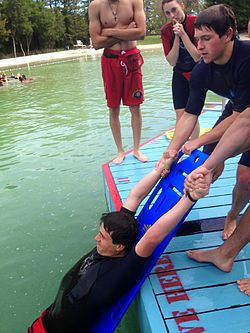Reservoir sedimentation issue
In 2014, the San Jose Mercury-News, a local newspaper, reported that the Cull Creek Reservoir Dam would likely be drained soon because it had been judged as seismically unsafe. This hazard was caused by tons of sediment that had deposited since the dam was constructed in 1963. [4] [b]
By 2014, the water layer was estimated to be only 6 feet (1.8 m) deep. [4] The Alameda County Flood Control Manager, Hank Ackerman, said that the reservoir receives 12,000 to 20,000 cubic yards of silt and debris every year, which is trapped behind the dam. He added that the problem had reached a point where it caused a massive fish kill in August 2013, and that EBRPD had ceased to restock the reservoir with fish. [4]
A temporary solution to the seismic concern was obtained in 2006 when engineers penetrated the concrete spillway with 12-inch pipe that relieved pressure on the dam by lowering the water level in the lake. Ackerman noted that dredging the lake to remove the sediment had been estimated to cost $16 million and require 28,000 round trips with double bottom dump semitrailers to remove the estimated 450,000 cubic yards of sediment. The dam would need to be reinforced after the silt is removed. [4]
Almeda County engineers have proposed to notch the reservoir's weir. This would let water flow downstream,leaving the accumulated sediment behind. Ackerman said that cost would be less than $1 million, and that the seismic threat would be eliminated because the (California) Division of Safety of Dams would no longer consider it a dam if it didn't hold back water.” [4]
This page is based on this
Wikipedia article Text is available under the
CC BY-SA 4.0 license; additional terms may apply.
Images, videos and audio are available under their respective licenses.


